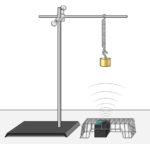Experiments
Here are experiments our science specialists have selected to support this IB* topic.

Simple Harmonic Motion
Experiment #15 from Physics with Vernier
- Measure the position and velocity as a function of time for an oscillating mass and spring system.
- Determine the amplitude, period, and phase constant of the observed simple harmonic motion.
- Compare the observed motion of a mass and spring system to a mathematical model of simple harmonic motion.

The Mathematical Model of Simple Harmonic Motion
Experiment #15 from Advanced Physics with Vernier — Mechanics
In this experiment, you will
- Collect position vs. time data as a mass, hanging from a spring, is set in an oscillating motion.
- Determine the best fit equation for the position vs. time graph of an object undergoing simple harmonic motion (SHM).
- Define the terms amplitude, offset, phase shift, period and angular frequency in the context of SHM.
- Relate the parameters in the best-fit equation for a position vs. time graph to their physical counterparts in the system.
- Use deductive reasoning to predict the system mass required to produce a given value of angular frequency in the curve fit to SHM.
- Educational Standard
- International Baccalaureate (IB) 2025
- Subject
- Physics
- Theme
- C Wave behaviour
- Topic
- C.1 Simple harmonic motion
- Level
- Standard level and higher level
* The IB Diploma Program is an official program of the International Baccalaureate Organization (IBO) which authorizes schools to offer it. The material available here has been developed independently of the IBO and is not endorsed by it.
